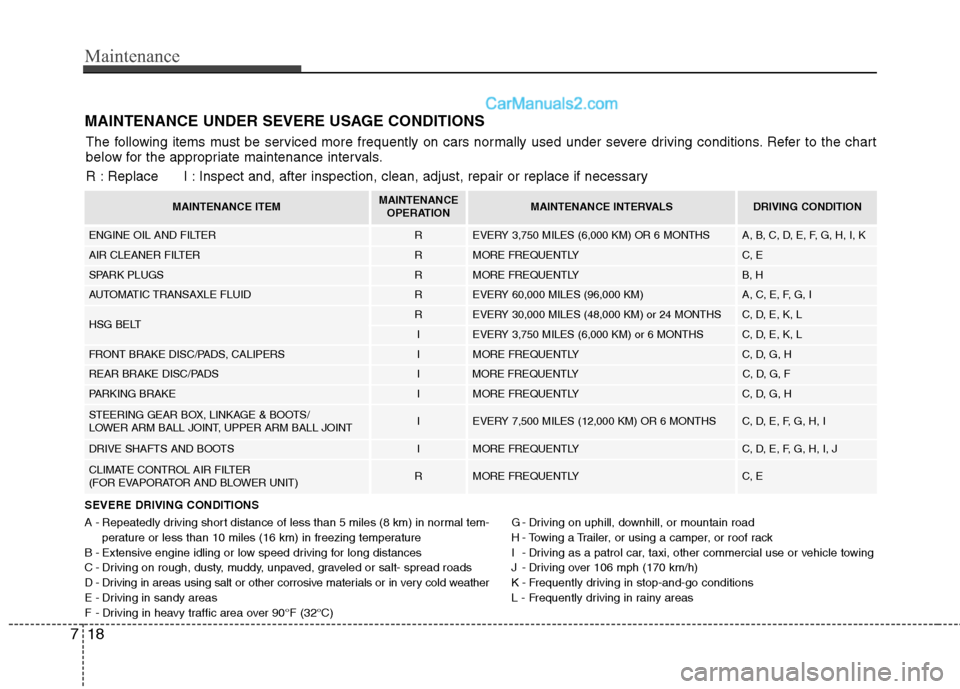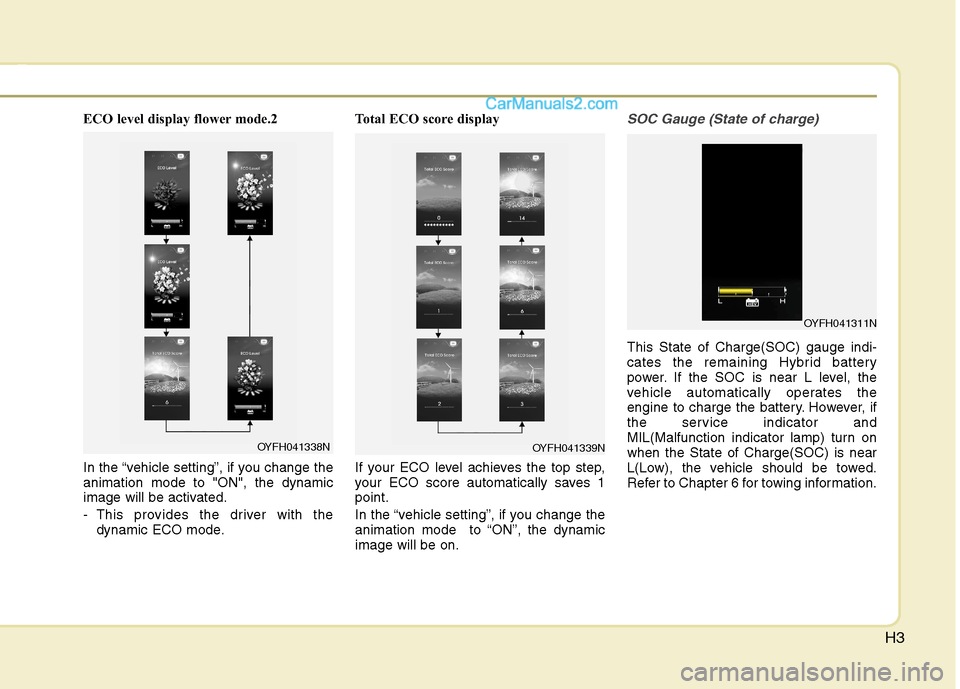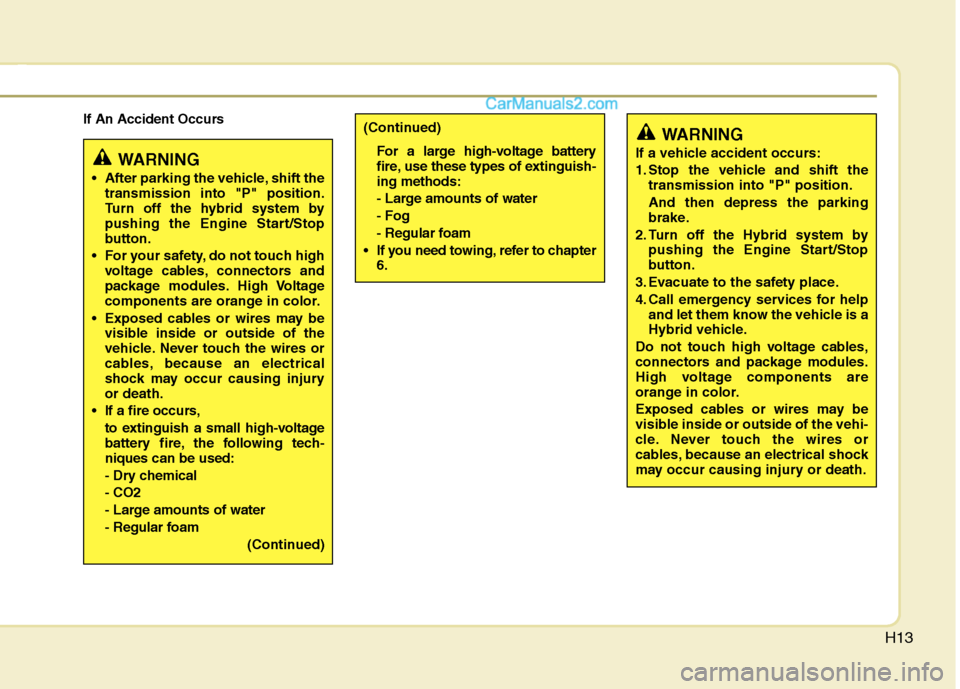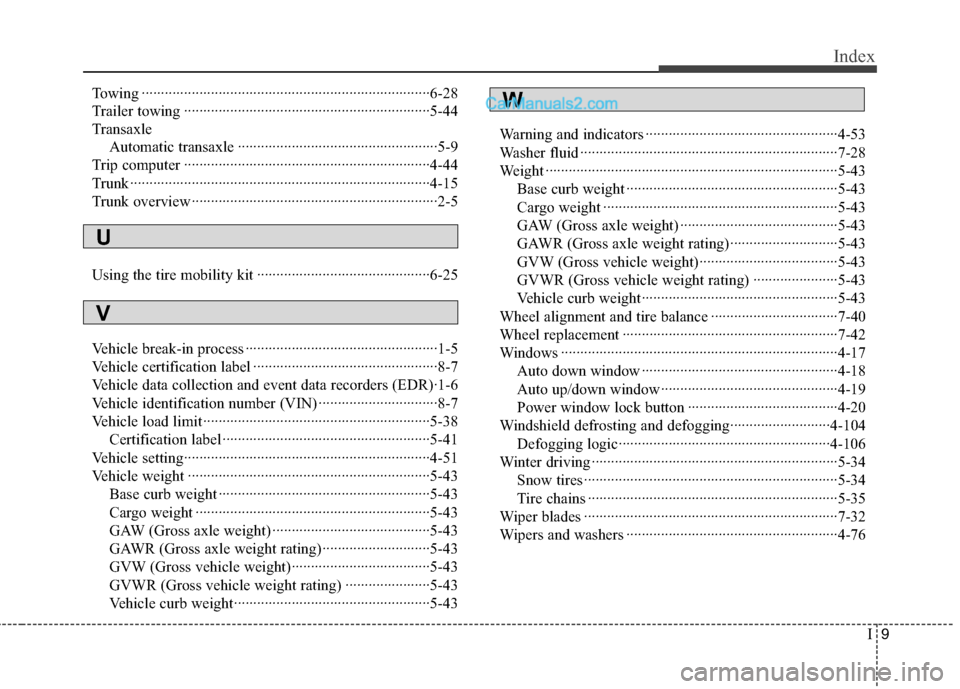2013 Hyundai Sonata Hybrid towing
[x] Cancel search: towingPage 314 of 425

What to do in an emergency
28 6
TOWING
Towing service
If emergency towing is necessary, we
recommend having it done by an author-
ized Hyundai dealer or a commercial
tow-truck service. Proper lifting and tow-
ing procedures are necessary to prevent
damage to the vehicle. The use of wheel
dollies or flatbed is recommended.It is acceptable to tow the vehicle with the
rear wheels on the ground (without dol-
lies) and the front wheels off the ground.
If any of the loaded wheels or suspen-
sion components are damaged or the
vehicle is being towed with the front
wheels on the ground, use a towing dolly
under the front wheels.
When being towed by a commercial tow
truck and wheel dollies are not used, the
front of the vehicle should always be lift-
ed, not the rear.
OMC045012dolly
A
B
C
CAUTION
Do not tow with sling-type equip-
ment. Use wheel lift or flatbed
equipment.
Never tow the vehicle backwards
with the front wheels on the
ground as this may cause dam-
age to the vehicle.
HXD02
HXD03
Page 332 of 425

Maintenance
18 7
MAINTENANCE UNDER SEVERE USAGE CONDITIONS
SEVERE DRIVING CONDITIONS
A - Repeatedly driving short distance of less than 5 miles (8 km) in normal tem-
perature or less than 10 miles (16 km) in freezing temperature
B - Extensive engine idling or low speed driving for long distances
C - Driving on rough, dusty, muddy, unpaved, graveled or salt- spread roads
D - Driving in areas using salt or other corrosive materials or in very cold weather
E - Driving in sandy areas
F - Driving in heavy traffic area over 90°F (32°C)G - Driving on uphill, downhill, or mountain road
H - Towing a Trailer, or using a camper, or roof rack
I - Driving as a patrol car, taxi, other commercial use or vehicle towing
J - Driving over 106 mph (170 km/h)
K - Frequently driving in stop-and-go conditions
L - Frequently driving in rainy areas
The following items must be serviced more frequently on cars normally used under severe driving conditions. Refer to the chart
below for the appropriate maintenance intervals.
R : Replace I : Inspect and, after inspection, clean, adjust, repair or replace if necessary
MAINTENANCE ITEMMAINTENANCE
OPERATIONMAINTENANCE INTERVALSDRIVING CONDITION
ENGINE OIL AND FILTERREVERY 3,750 MILES (6,000 KM) OR 6 MONTHSA, B, C, D, E, F, G, H, I, K
AIR CLEANER FILTERRMORE FREQUENTLYC, E
SPARK PLUGSRMORE FREQUENTLYB, H
AUTOMATIC TRANSAXLE FLUIDREVERY 60,000 MILES (96,000 KM) A, C, E, F, G, I
HSG BELT REVERY 30,000 MILES (48,000 KM) or 24 MONTHS C, D, E, K, L
IEVERY 3,750 MILES (6,000 KM) or 6 MONTHS C, D, E, K, L
FRONT BRAKE DISC/PADS, CALIPERSIMORE FREQUENTLYC, D, G, H
REAR BRAKE DISC/PADSIMORE FREQUENTLYC, D, G, F
PARKING BRAKEIMORE FREQUENTLYC, D, G, H
STEERING GEAR BOX, LINKAGE & BOOTS/
LOWER ARM BALL JOINT, UPPER ARM BALL JOINTIEVERY 7,500 MILES (12,000 KM) OR 6 MONTHSC, D, E, F, G, H, I
DRIVE SHAFTS AND BOOTSIMORE FREQUENTLYC, D, E, F, G, H, I, J
CLIMATE CONTROL AIR FILTER
(FOR EVAPORATOR AND BLOWER UNIT)RMORE FREQUENTLYC, E
Page 405 of 425

H3
ECO level display flower mode.2
In the “vehicle setting”, if you change the
animation mode to "ON", the dynamic
image will be activated.
- This provides the driver with the
dynamic ECO mode.Total ECO score display
If your ECO level achieves the top step,
your ECO score automatically saves 1
point.
In the “vehicle setting”, if you change the
animation mode to “ON”, the dynamic
image will be on.SOC Gauge (State of charge)
This State of Charge(SOC) gauge indi-
cates the remaining Hybrid battery
power. If the SOC is near L level, the
vehicle automatically operates the
engine to charge the battery. However, if
the service indicator and
MIL(Malfunction indicator lamp) turn on
when the State of Charge(SOC) is near
L(Low), the vehicle should be towed.
Refer to Chapter 6 for towing information.
OYFH041338NOYFH041339N
OYFH041311N
Page 415 of 425

H13
If An Accident Occurs
WARNING
After parking the vehicle, shift the
transmission into "P" position.
Turn off the hybrid system by
pushing the Engine Start/Stop
button.
For your safety, do not touch high
voltage cables, connectors and
package modules. High Voltage
components are orange in color.
Exposed cables or wires may be
visible inside or outside of the
vehicle. Never touch the wires or
cables, because an electrical
shock may occur causing injury
or death.
If a fire occurs,
to extinguish a small high-voltage
battery fire, the following tech-
niques can be used:
- Dry chemical
- CO2
- Large amounts of water
- Regular foam
(Continued)
WARNING
If a vehicle accident occurs:
1. Stop the vehicle and shift the
transmission into "P" position.
And then depress the parking
brake.
2. Turn off the Hybrid system by
pushing the Engine Start/Stop
button.
3. Evacuate to the safety place.
4. Call emergency services for help
and let them know the vehicle is a
Hybrid vehicle.
Do not touch high voltage cables,
connectors and package modules.
High voltage components are
orange in color.
Exposed cables or wires may be
visible inside or outside of the vehi-
cle. Never touch the wires or
cables, because an electrical shock
may occur causing injury or death.
(Continued)
For a large high-voltage battery
fire, use these types of extinguish-
ing methods:
- Large amounts of water
- Fog
- Regular foam
If you need towing, refer to chapter
6.
Page 425 of 425

I9
Index
Towing ···········································································6-28
Trailer towing ································································5-44
Transaxle
Automatic transaxle ····················································5-9
Trip computer ································································4-44
Trunk ··············································································4-15
Trunk overview ································································2-5
Using the tire mobility kit ·············································6-25
Vehicle break-in process ··················································1-5
Vehicle certification label ················································8-7
Vehicle data collection and event data recorders (EDR)·1-6
Vehicle identification number (VIN) ·······························8-7
Vehicle load limit ···························································5-38
Certification label ······················································5-41
Vehicle setting································································4-51
Vehicle weight ·······························································5-43
Base curb weight ·······················································5-43
Cargo weight ·····························································5-43
GAW (Gross axle weight) ·········································5-43
GAWR (Gross axle weight rating)····························5-43
GVW (Gross vehicle weight)····································5-43
GVWR (Gross vehicle weight rating) ······················5-43
Vehicle curb weight···················································5-43Warning and indicators ··················································4-53
Washer fluid ···································································7-28
Weight ············································································5-43
Base curb weight ·······················································5-43
Cargo weight ·····························································5-43
GAW (Gross axle weight) ·········································5-43
GAWR (Gross axle weight rating)····························5-43
GVW (Gross vehicle weight)····································5-43
GVWR (Gross vehicle weight rating) ······················5-43
Vehicle curb weight···················································5-43
Wheel alignment and tire balance ·································7-40
Wheel replacement ························································7-42
Windows ········································································4-17
Auto down window ···················································4-18
Auto up/down window ··············································4-19
Power window lock button ·······································4-20
Windshield defrosting and defogging··························4-104
Defogging logic·······················································4-106
Winter driving ································································5-34
Snow tires ··································································5-34
Tire chains ·································································5-35
Wiper blades ··································································7-32
Wipers and washers ·······················································4-76
U
V
W